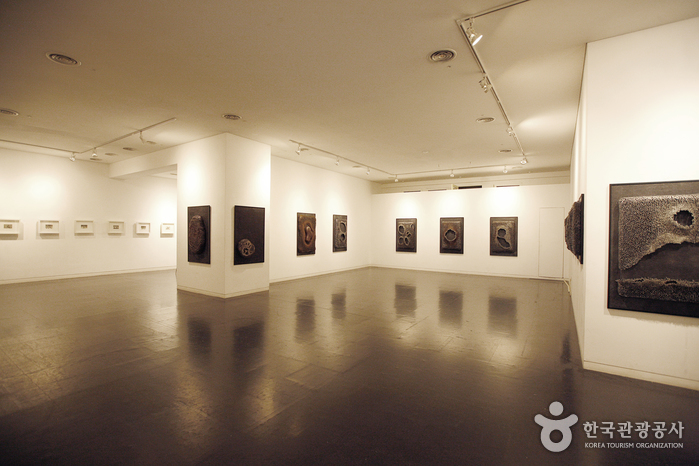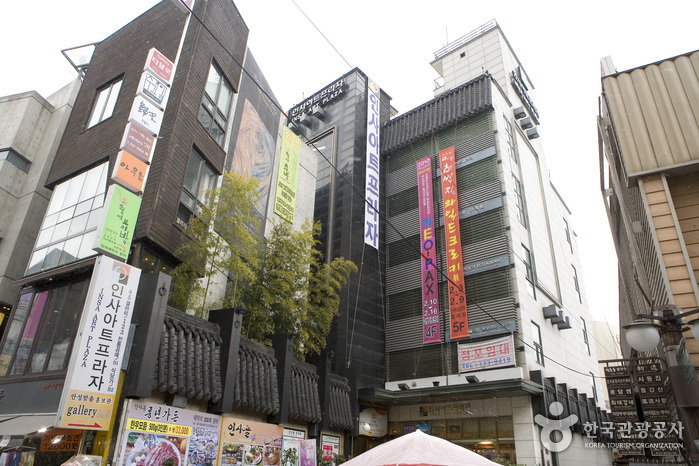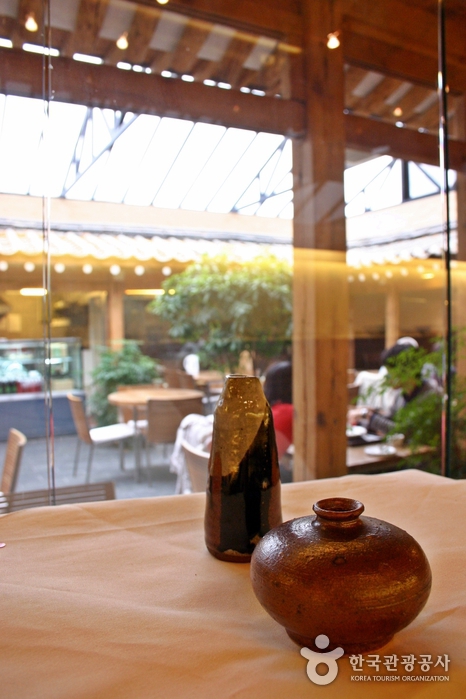Tienda de Suvenires Coreanos en Insa-dong (한국관광명품점(인사동))
175.0M 2024-02-19
Insadong 5-gil 14, Jongno-gu, Seúl
Centro de Arte de Seúl Galería Gongpyeong (서울아트센터 공평갤러리)
177.7M 2023-01-03
Samil-daero 30-gil 10-3, Jongno-gu, Seúl.
Balwoo Gongyang (발우공양)
208.1M 2025-05-29
56 Ujeongguk-ro, Jongno-gu, Seoul
Centro de Información de Estancias en Templos (템플스테이 홍보관)
208.1M 2022-09-28
Ujeongguk-ro 56, Jongno-gu, Seúl
El centro es un complejo cultural de cinco plantas donde se encuentran la mayoría de oficinas responsables de las estancias en templos, centros de información, centros educativos, un restaurante de comida budista tradicional llamado Balwoo Gongyang, entre otros.
Insa Art Plaza (인사아트프라자)
209.1M 2024-02-21
Insadong-gil 34-1, Jongno-gu, Seúl
Imun Seolnongtang (이문설농탕)
216.8M 2025-08-08
38-13, Ujeongguk-ro, Jongno-gu, Seoul
Museo del Té Areumdaun (Beautiful Tea Museum) (아름다운 차박물관)
220.4M 2025-12-17
Insadong-gil 19-11, Jongno-gu, Seúl.
El Museo del Té Areumdaun es un espacio multicultural y comprende una galería que invita a descubrir obras de porcelana realizadas por jóvenes artistas, una tienda que propone alrededor de 110 tipos de té de Corea, China, Japón, Taiwán, Sri Lanka, India y países de Europa, y un salón para degustar un buen té. La sala de exposiciones se divide en tres secciones destinadas respectivamente a Corea, China y el Tíbet. Allí se exponen diversos estilos de servicios de té para tener una impresión de las características del arte del té de cada país. Asimismo, jóvenes artistas organizan exposiciones y ventas. El museo expone cerca de 130 tipos de té, podrá comprar o degustar diferentes variedades como té clásico, té verde, té azul, té negro, té a las hierbas, té a las flores, etc.
Areumdaun Cha Bangmulgwan (Beautiful Tea Museum) (아름다운차박물관)
220.4M 2025-05-27
19-11, Insadong-gil, Jongno-gu, Seoul
In addition to gourmet restaurants, traditional tea houses are a popular destination in Insa-dong. Among them, we recommend Areumdaun Cha Bangmulgwan, where you can taste more than 100 types of tea, including Korean, Chinese, Japanese, and Taiwanese. The shop also serves as a museum and gallery. Enjoy a leisurely cup of tea as you appreciate the art that is on display.
Barrio de Insa-dong (인사동)
223.0M 2025-05-30
Insadong-gil 62, Jongno-gu, Seúl
El barrio de Insa-dong, situado en el corazón de la ciudad, es un lugar importante donde se intercambian artículos antiguos, pero valiosos. En la zona de Insa-dong hay una calle principal con un laberinto de callejuelas que se despliegan a cada lado. En aquellas callejuelas hay galerías, restaurantes tradicionales, casas de té tradicional y cafés. Las tiendas en Insa-dong son muy populares entre los grupos de todas las edades gracias al ambiente singular y único que ofrece cada una de ellas.
Las galerías de arte son el mismísimo latir del corazón de Insa-dong. En él hay un centenar de galerías donde se pueden contemplar todo tipo de ejemplares de las bellas artes de Corea, desde pinturas hasta esculturas. Entre las galerías de arte más famosas se encuentran la Galería Hakgojae, que funciona como el centro de arte folclórico; la Galería Gana, que promueve a muchos artistas de talentos prometedores, y el Centro de Arte Gana.
Las casas de té y los restaurantes complementan perfectamente las galerías de bellas artes. Al principio podrá resultar difícil hallarlos, pero si se toma el tiempo suficiente para recorrer las pequeñas calles serpenteantes, la “búsqueda” en sí puede llegar a ser divertida. En caso de que deseara elegir una sola casa de té de las cientas que hay aquí, Gwicheon podría llegar a ser el lugar ideal para conocer. La esposa del poeta Cheon Sang-byeong es su propietaria. El lugar no es muy grande, pero allí podrá ver fotos y libros de poetas famosos. El té de membrillo es el mejor de esta casa y es famoso por su fragancia.
Todos los domingos está prohibido el acceso de los coches a las calles del área de 10:00 a 22:00 por ordenanza municipal, de modo que el lugar se convierte en un espacio cultural. Precisamente este es el momento en el que los comercios se vuelcan fuera a exponer sus artículos. No solo las tiendas que están aquí sino también gente de todas partes viene aquí e instala puestos de comercio ambulante. De todos estos se pueden mencionar, como ejemplo, los vendedores de dulces coreanos y los adivinos ancianos.
También se desarrollan interpretaciones de obras tradicionales y exhibiciones. Insa-dong es especialmente popular entre los turistas extranjeros, pues aquí pueden ver y vivir directamente la experiencia de la cultura tradicional coreana, y también porque pueden adquirir piezas de bellas artes. En la calle podrá probar melcochas coreanas y el tradicional pajeon (tortilla coreana), y ver a numerosos extranjeros sumidos en las alegres festividades.
Yangbandaek (양반댁)
233.2M 2025-05-14
19-18, Insadong-gil, Jongno-gu, Seoul




 Español
Español
 한국어
한국어 English
English 日本語
日本語 中文(简体)
中文(简体) Deutsch
Deutsch Français
Français Русский
Русский